Strategic Human Resource Management Analysis: Sainsbury's Report
VerifiedAdded on 2020/02/03
|20
|6221
|33
Report
AI Summary
This report provides a comprehensive analysis of human resource management (HRM) practices at Sainsbury's, a major UK supermarket chain. It begins by examining the Guest model of HRM, outlining its key components and how Sainsbury's applies them to achieve its strategic goals. The report then contrasts Sainsbury's HRM approach with personnel management, highlighting differences in line manager roles, planning horizons, and organizational structures. Furthermore, it explores the implications of HRM strategies for line managers and employees, emphasizing their roles in developing a strategic approach. The report delves into the concept of flexibility in the workplace, discussing various methods Sainsbury's can adopt to enhance employee performance, such as flexible working shifts and work-from-home options. It also covers issues of discrimination, equal opportunities, diversity, and performance management. Finally, the report discusses the importance of employee welfare and concludes with a summary of its key findings, offering insights into how Sainsbury's manages its workforce to achieve organizational success.
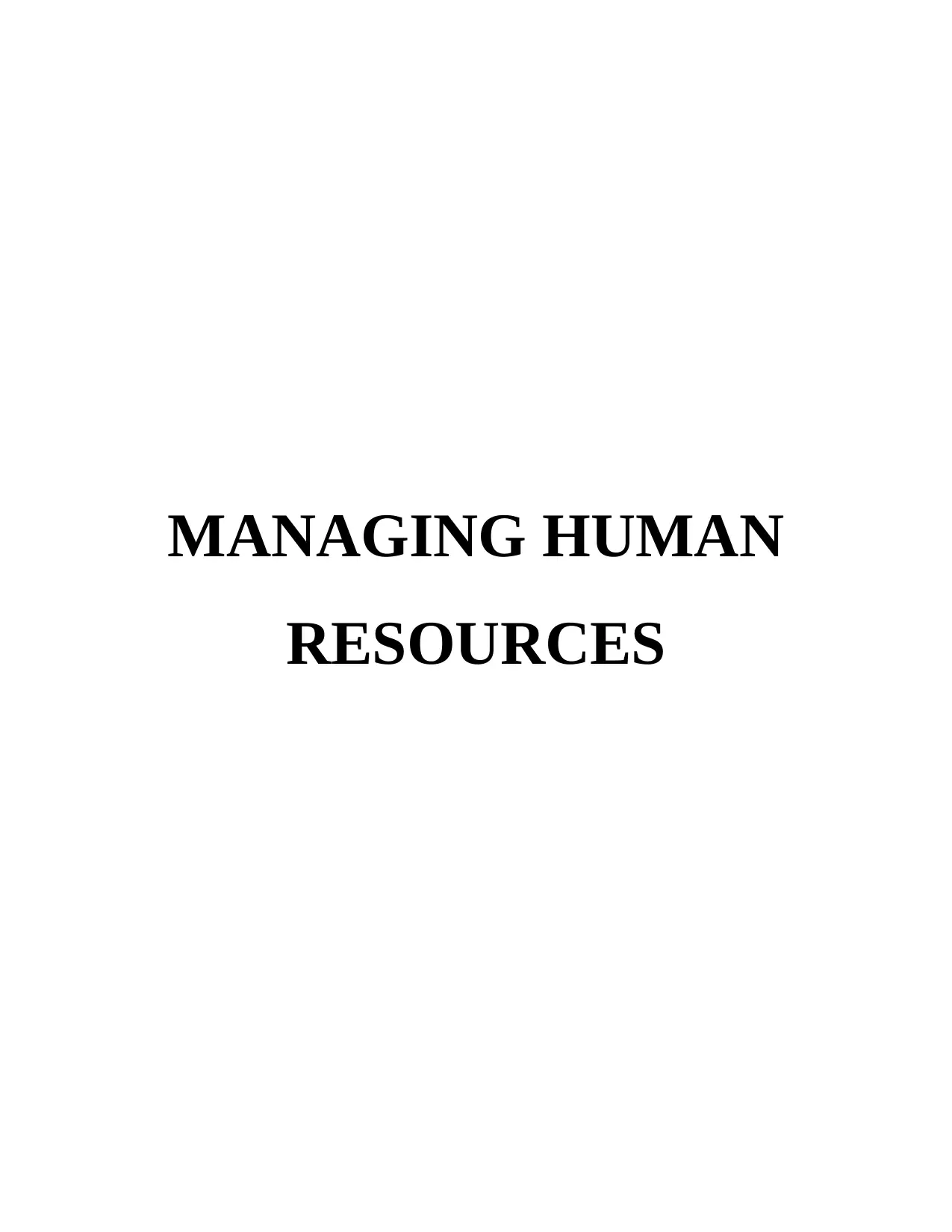
MANAGING HUMAN
RESOURCES
RESOURCES
Paraphrase This Document
Need a fresh take? Get an instant paraphrase of this document with our AI Paraphraser
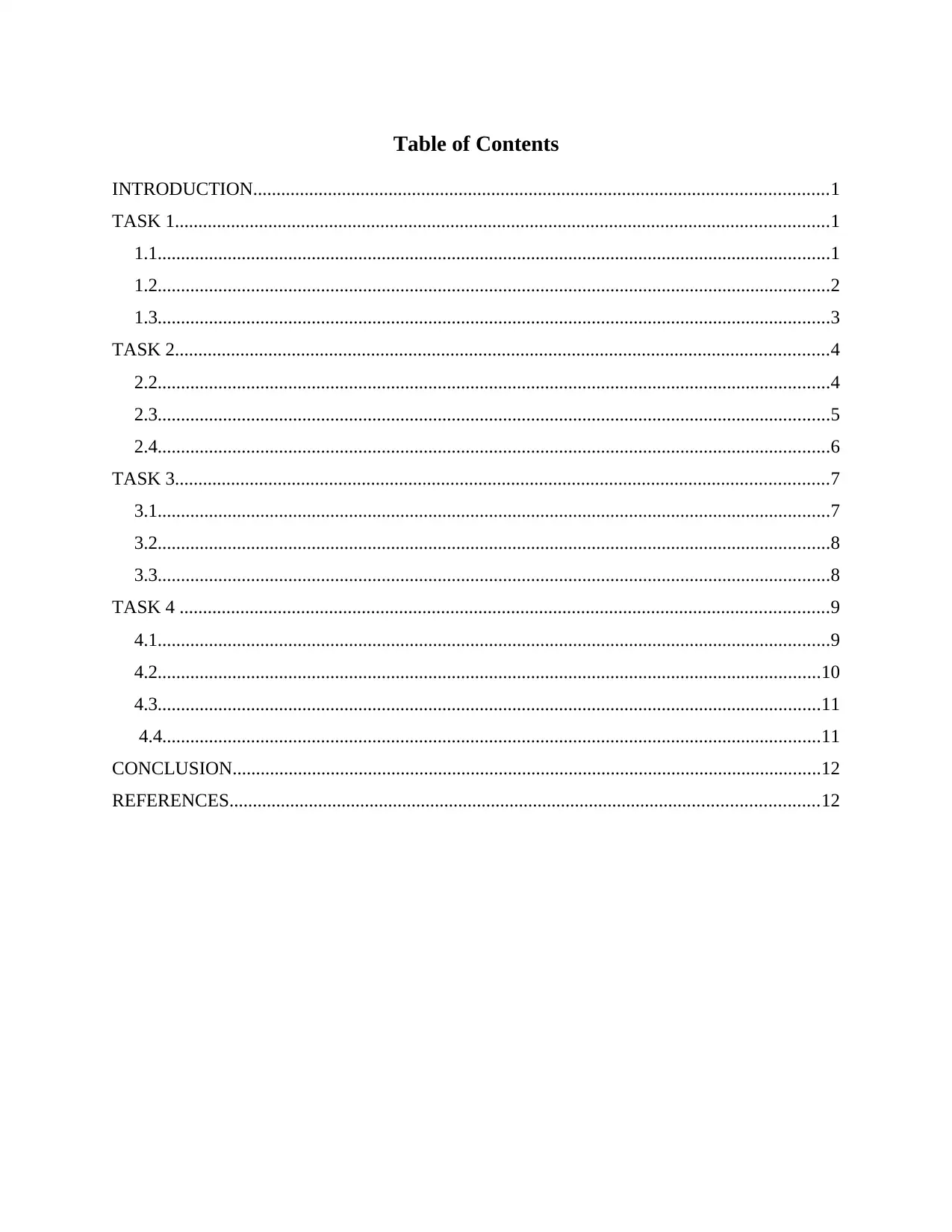
Table of Contents
INTRODUCTION...........................................................................................................................1
TASK 1............................................................................................................................................1
1.1................................................................................................................................................1
1.2................................................................................................................................................2
1.3................................................................................................................................................3
TASK 2............................................................................................................................................4
2.2................................................................................................................................................4
2.3................................................................................................................................................5
2.4................................................................................................................................................6
TASK 3............................................................................................................................................7
3.1................................................................................................................................................7
3.2................................................................................................................................................8
3.3................................................................................................................................................8
TASK 4 ...........................................................................................................................................9
4.1................................................................................................................................................9
4.2..............................................................................................................................................10
4.3..............................................................................................................................................11
4.4.............................................................................................................................................11
CONCLUSION..............................................................................................................................12
REFERENCES..............................................................................................................................12
INTRODUCTION...........................................................................................................................1
TASK 1............................................................................................................................................1
1.1................................................................................................................................................1
1.2................................................................................................................................................2
1.3................................................................................................................................................3
TASK 2............................................................................................................................................4
2.2................................................................................................................................................4
2.3................................................................................................................................................5
2.4................................................................................................................................................6
TASK 3............................................................................................................................................7
3.1................................................................................................................................................7
3.2................................................................................................................................................8
3.3................................................................................................................................................8
TASK 4 ...........................................................................................................................................9
4.1................................................................................................................................................9
4.2..............................................................................................................................................10
4.3..............................................................................................................................................11
4.4.............................................................................................................................................11
CONCLUSION..............................................................................................................................12
REFERENCES..............................................................................................................................12
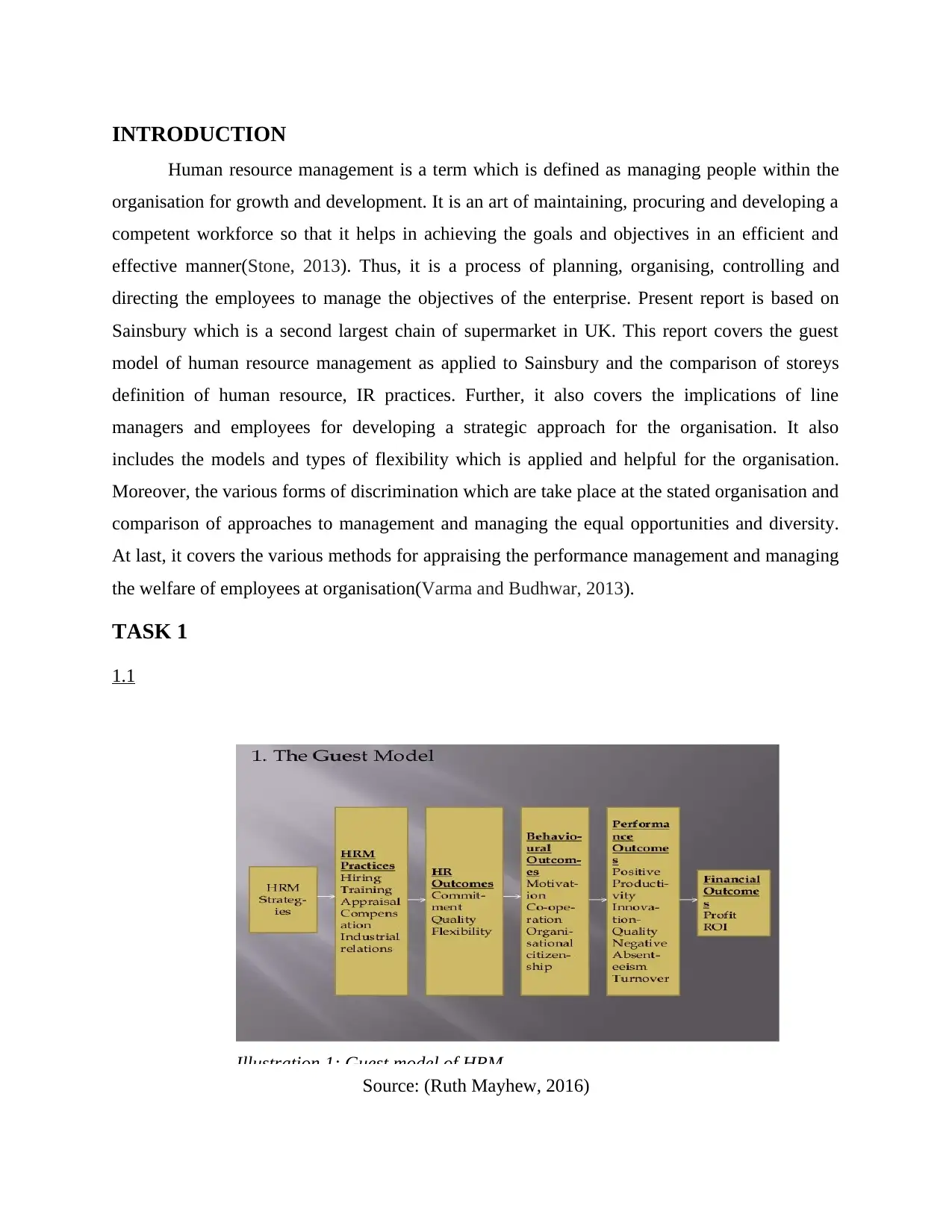
INTRODUCTION
Human resource management is a term which is defined as managing people within the
organisation for growth and development. It is an art of maintaining, procuring and developing a
competent workforce so that it helps in achieving the goals and objectives in an efficient and
effective manner(Stone, 2013). Thus, it is a process of planning, organising, controlling and
directing the employees to manage the objectives of the enterprise. Present report is based on
Sainsbury which is a second largest chain of supermarket in UK. This report covers the guest
model of human resource management as applied to Sainsbury and the comparison of storeys
definition of human resource, IR practices. Further, it also covers the implications of line
managers and employees for developing a strategic approach for the organisation. It also
includes the models and types of flexibility which is applied and helpful for the organisation.
Moreover, the various forms of discrimination which are take place at the stated organisation and
comparison of approaches to management and managing the equal opportunities and diversity.
At last, it covers the various methods for appraising the performance management and managing
the welfare of employees at organisation(Varma and Budhwar, 2013).
TASK 1
1.1
Source: (Ruth Mayhew, 2016)
Illustration 1: Guest model of HRM
Human resource management is a term which is defined as managing people within the
organisation for growth and development. It is an art of maintaining, procuring and developing a
competent workforce so that it helps in achieving the goals and objectives in an efficient and
effective manner(Stone, 2013). Thus, it is a process of planning, organising, controlling and
directing the employees to manage the objectives of the enterprise. Present report is based on
Sainsbury which is a second largest chain of supermarket in UK. This report covers the guest
model of human resource management as applied to Sainsbury and the comparison of storeys
definition of human resource, IR practices. Further, it also covers the implications of line
managers and employees for developing a strategic approach for the organisation. It also
includes the models and types of flexibility which is applied and helpful for the organisation.
Moreover, the various forms of discrimination which are take place at the stated organisation and
comparison of approaches to management and managing the equal opportunities and diversity.
At last, it covers the various methods for appraising the performance management and managing
the welfare of employees at organisation(Varma and Budhwar, 2013).
TASK 1
1.1
Source: (Ruth Mayhew, 2016)
Illustration 1: Guest model of HRM
⊘ This is a preview!⊘
Do you want full access?
Subscribe today to unlock all pages.

Trusted by 1+ million students worldwide
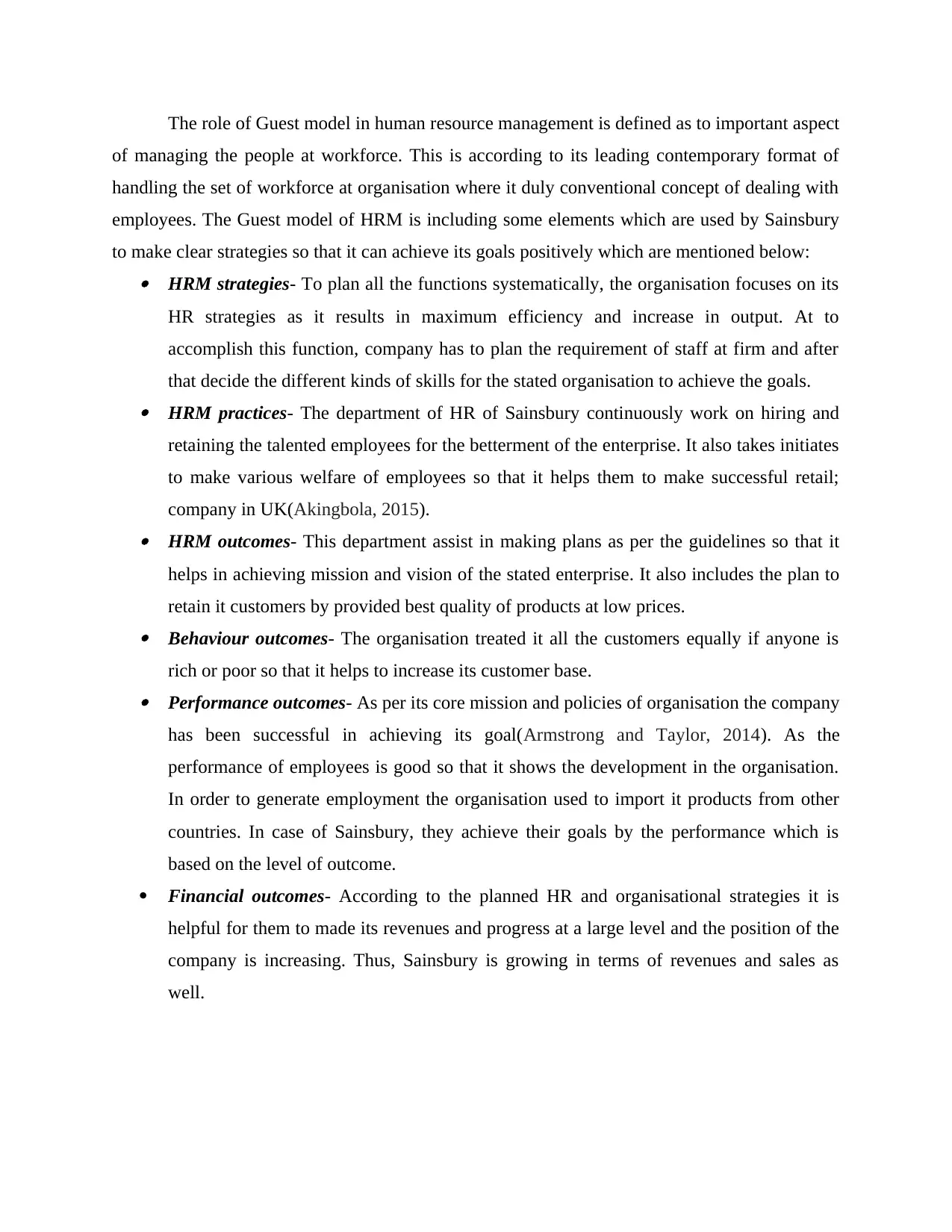
The role of Guest model in human resource management is defined as to important aspect
of managing the people at workforce. This is according to its leading contemporary format of
handling the set of workforce at organisation where it duly conventional concept of dealing with
employees. The Guest model of HRM is including some elements which are used by Sainsbury
to make clear strategies so that it can achieve its goals positively which are mentioned below: HRM strategies- To plan all the functions systematically, the organisation focuses on its
HR strategies as it results in maximum efficiency and increase in output. At to
accomplish this function, company has to plan the requirement of staff at firm and after
that decide the different kinds of skills for the stated organisation to achieve the goals. HRM practices- The department of HR of Sainsbury continuously work on hiring and
retaining the talented employees for the betterment of the enterprise. It also takes initiates
to make various welfare of employees so that it helps them to make successful retail;
company in UK(Akingbola, 2015). HRM outcomes- This department assist in making plans as per the guidelines so that it
helps in achieving mission and vision of the stated enterprise. It also includes the plan to
retain it customers by provided best quality of products at low prices. Behaviour outcomes- The organisation treated it all the customers equally if anyone is
rich or poor so that it helps to increase its customer base. Performance outcomes- As per its core mission and policies of organisation the company
has been successful in achieving its goal(Armstrong and Taylor, 2014). As the
performance of employees is good so that it shows the development in the organisation.
In order to generate employment the organisation used to import it products from other
countries. In case of Sainsbury, they achieve their goals by the performance which is
based on the level of outcome.
Financial outcomes- According to the planned HR and organisational strategies it is
helpful for them to made its revenues and progress at a large level and the position of the
company is increasing. Thus, Sainsbury is growing in terms of revenues and sales as
well.
of managing the people at workforce. This is according to its leading contemporary format of
handling the set of workforce at organisation where it duly conventional concept of dealing with
employees. The Guest model of HRM is including some elements which are used by Sainsbury
to make clear strategies so that it can achieve its goals positively which are mentioned below: HRM strategies- To plan all the functions systematically, the organisation focuses on its
HR strategies as it results in maximum efficiency and increase in output. At to
accomplish this function, company has to plan the requirement of staff at firm and after
that decide the different kinds of skills for the stated organisation to achieve the goals. HRM practices- The department of HR of Sainsbury continuously work on hiring and
retaining the talented employees for the betterment of the enterprise. It also takes initiates
to make various welfare of employees so that it helps them to make successful retail;
company in UK(Akingbola, 2015). HRM outcomes- This department assist in making plans as per the guidelines so that it
helps in achieving mission and vision of the stated enterprise. It also includes the plan to
retain it customers by provided best quality of products at low prices. Behaviour outcomes- The organisation treated it all the customers equally if anyone is
rich or poor so that it helps to increase its customer base. Performance outcomes- As per its core mission and policies of organisation the company
has been successful in achieving its goal(Armstrong and Taylor, 2014). As the
performance of employees is good so that it shows the development in the organisation.
In order to generate employment the organisation used to import it products from other
countries. In case of Sainsbury, they achieve their goals by the performance which is
based on the level of outcome.
Financial outcomes- According to the planned HR and organisational strategies it is
helpful for them to made its revenues and progress at a large level and the position of the
company is increasing. Thus, Sainsbury is growing in terms of revenues and sales as
well.
Paraphrase This Document
Need a fresh take? Get an instant paraphrase of this document with our AI Paraphraser
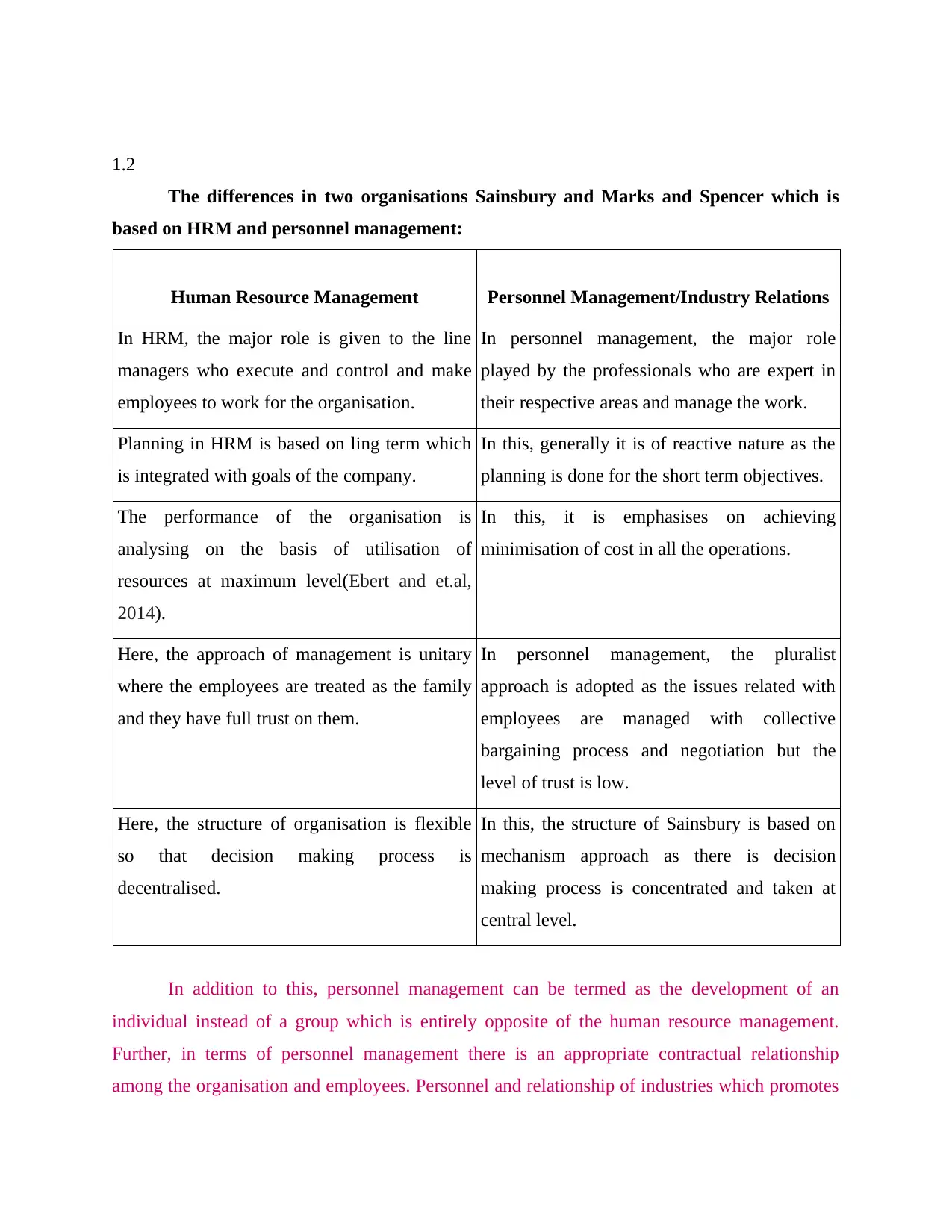
1.2
The differences in two organisations Sainsbury and Marks and Spencer which is
based on HRM and personnel management:
Human Resource Management Personnel Management/Industry Relations
In HRM, the major role is given to the line
managers who execute and control and make
employees to work for the organisation.
In personnel management, the major role
played by the professionals who are expert in
their respective areas and manage the work.
Planning in HRM is based on ling term which
is integrated with goals of the company.
In this, generally it is of reactive nature as the
planning is done for the short term objectives.
The performance of the organisation is
analysing on the basis of utilisation of
resources at maximum level(Ebert and et.al,
2014).
In this, it is emphasises on achieving
minimisation of cost in all the operations.
Here, the approach of management is unitary
where the employees are treated as the family
and they have full trust on them.
In personnel management, the pluralist
approach is adopted as the issues related with
employees are managed with collective
bargaining process and negotiation but the
level of trust is low.
Here, the structure of organisation is flexible
so that decision making process is
decentralised.
In this, the structure of Sainsbury is based on
mechanism approach as there is decision
making process is concentrated and taken at
central level.
In addition to this, personnel management can be termed as the development of an
individual instead of a group which is entirely opposite of the human resource management.
Further, in terms of personnel management there is an appropriate contractual relationship
among the organisation and employees. Personnel and relationship of industries which promotes
The differences in two organisations Sainsbury and Marks and Spencer which is
based on HRM and personnel management:
Human Resource Management Personnel Management/Industry Relations
In HRM, the major role is given to the line
managers who execute and control and make
employees to work for the organisation.
In personnel management, the major role
played by the professionals who are expert in
their respective areas and manage the work.
Planning in HRM is based on ling term which
is integrated with goals of the company.
In this, generally it is of reactive nature as the
planning is done for the short term objectives.
The performance of the organisation is
analysing on the basis of utilisation of
resources at maximum level(Ebert and et.al,
2014).
In this, it is emphasises on achieving
minimisation of cost in all the operations.
Here, the approach of management is unitary
where the employees are treated as the family
and they have full trust on them.
In personnel management, the pluralist
approach is adopted as the issues related with
employees are managed with collective
bargaining process and negotiation but the
level of trust is low.
Here, the structure of organisation is flexible
so that decision making process is
decentralised.
In this, the structure of Sainsbury is based on
mechanism approach as there is decision
making process is concentrated and taken at
central level.
In addition to this, personnel management can be termed as the development of an
individual instead of a group which is entirely opposite of the human resource management.
Further, in terms of personnel management there is an appropriate contractual relationship
among the organisation and employees. Personnel and relationship of industries which promotes
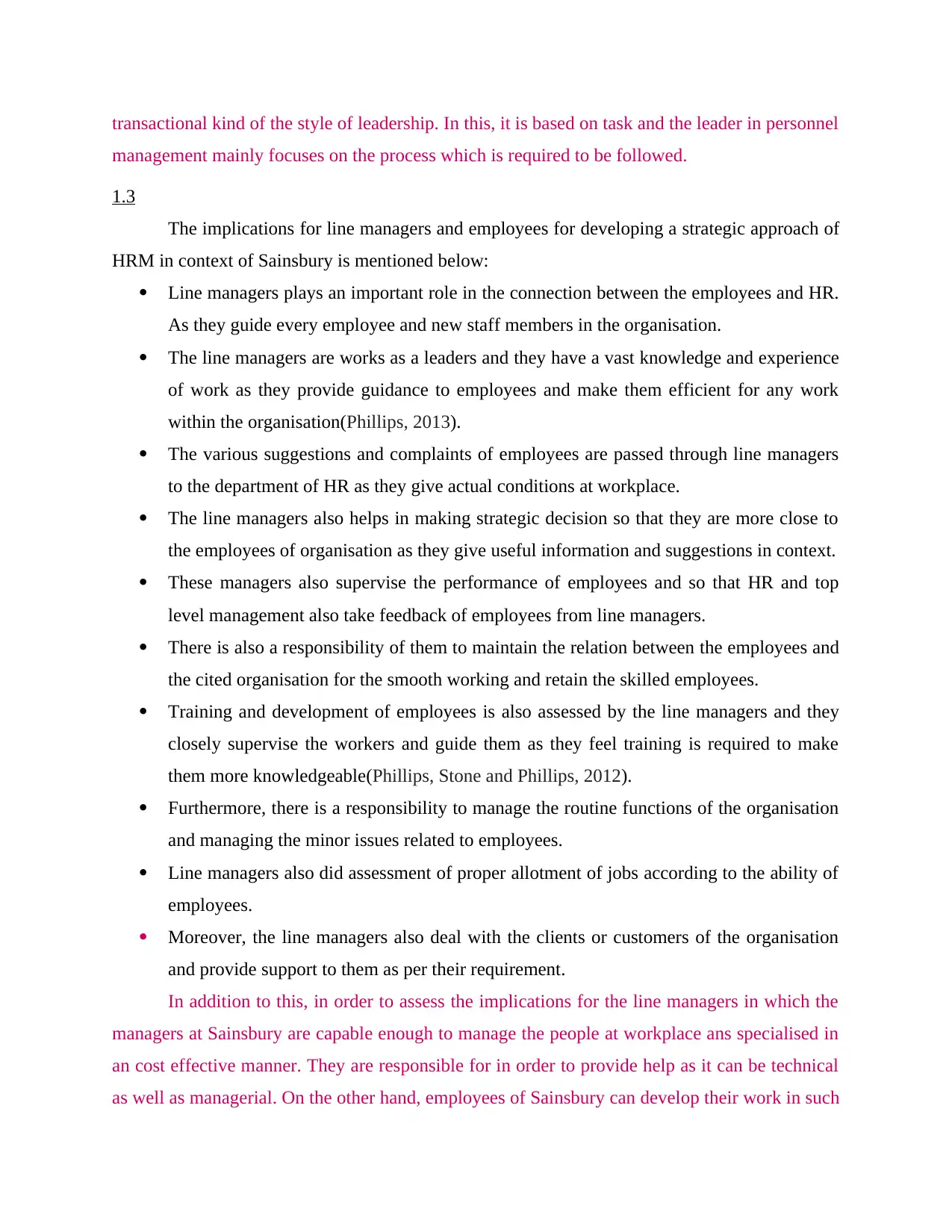
transactional kind of the style of leadership. In this, it is based on task and the leader in personnel
management mainly focuses on the process which is required to be followed.
1.3
The implications for line managers and employees for developing a strategic approach of
HRM in context of Sainsbury is mentioned below:
Line managers plays an important role in the connection between the employees and HR.
As they guide every employee and new staff members in the organisation.
The line managers are works as a leaders and they have a vast knowledge and experience
of work as they provide guidance to employees and make them efficient for any work
within the organisation(Phillips, 2013).
The various suggestions and complaints of employees are passed through line managers
to the department of HR as they give actual conditions at workplace.
The line managers also helps in making strategic decision so that they are more close to
the employees of organisation as they give useful information and suggestions in context.
These managers also supervise the performance of employees and so that HR and top
level management also take feedback of employees from line managers.
There is also a responsibility of them to maintain the relation between the employees and
the cited organisation for the smooth working and retain the skilled employees.
Training and development of employees is also assessed by the line managers and they
closely supervise the workers and guide them as they feel training is required to make
them more knowledgeable(Phillips, Stone and Phillips, 2012).
Furthermore, there is a responsibility to manage the routine functions of the organisation
and managing the minor issues related to employees.
Line managers also did assessment of proper allotment of jobs according to the ability of
employees.
Moreover, the line managers also deal with the clients or customers of the organisation
and provide support to them as per their requirement.
In addition to this, in order to assess the implications for the line managers in which the
managers at Sainsbury are capable enough to manage the people at workplace ans specialised in
an cost effective manner. They are responsible for in order to provide help as it can be technical
as well as managerial. On the other hand, employees of Sainsbury can develop their work in such
management mainly focuses on the process which is required to be followed.
1.3
The implications for line managers and employees for developing a strategic approach of
HRM in context of Sainsbury is mentioned below:
Line managers plays an important role in the connection between the employees and HR.
As they guide every employee and new staff members in the organisation.
The line managers are works as a leaders and they have a vast knowledge and experience
of work as they provide guidance to employees and make them efficient for any work
within the organisation(Phillips, 2013).
The various suggestions and complaints of employees are passed through line managers
to the department of HR as they give actual conditions at workplace.
The line managers also helps in making strategic decision so that they are more close to
the employees of organisation as they give useful information and suggestions in context.
These managers also supervise the performance of employees and so that HR and top
level management also take feedback of employees from line managers.
There is also a responsibility of them to maintain the relation between the employees and
the cited organisation for the smooth working and retain the skilled employees.
Training and development of employees is also assessed by the line managers and they
closely supervise the workers and guide them as they feel training is required to make
them more knowledgeable(Phillips, Stone and Phillips, 2012).
Furthermore, there is a responsibility to manage the routine functions of the organisation
and managing the minor issues related to employees.
Line managers also did assessment of proper allotment of jobs according to the ability of
employees.
Moreover, the line managers also deal with the clients or customers of the organisation
and provide support to them as per their requirement.
In addition to this, in order to assess the implications for the line managers in which the
managers at Sainsbury are capable enough to manage the people at workplace ans specialised in
an cost effective manner. They are responsible for in order to provide help as it can be technical
as well as managerial. On the other hand, employees of Sainsbury can develop their work in such
⊘ This is a preview!⊘
Do you want full access?
Subscribe today to unlock all pages.

Trusted by 1+ million students worldwide
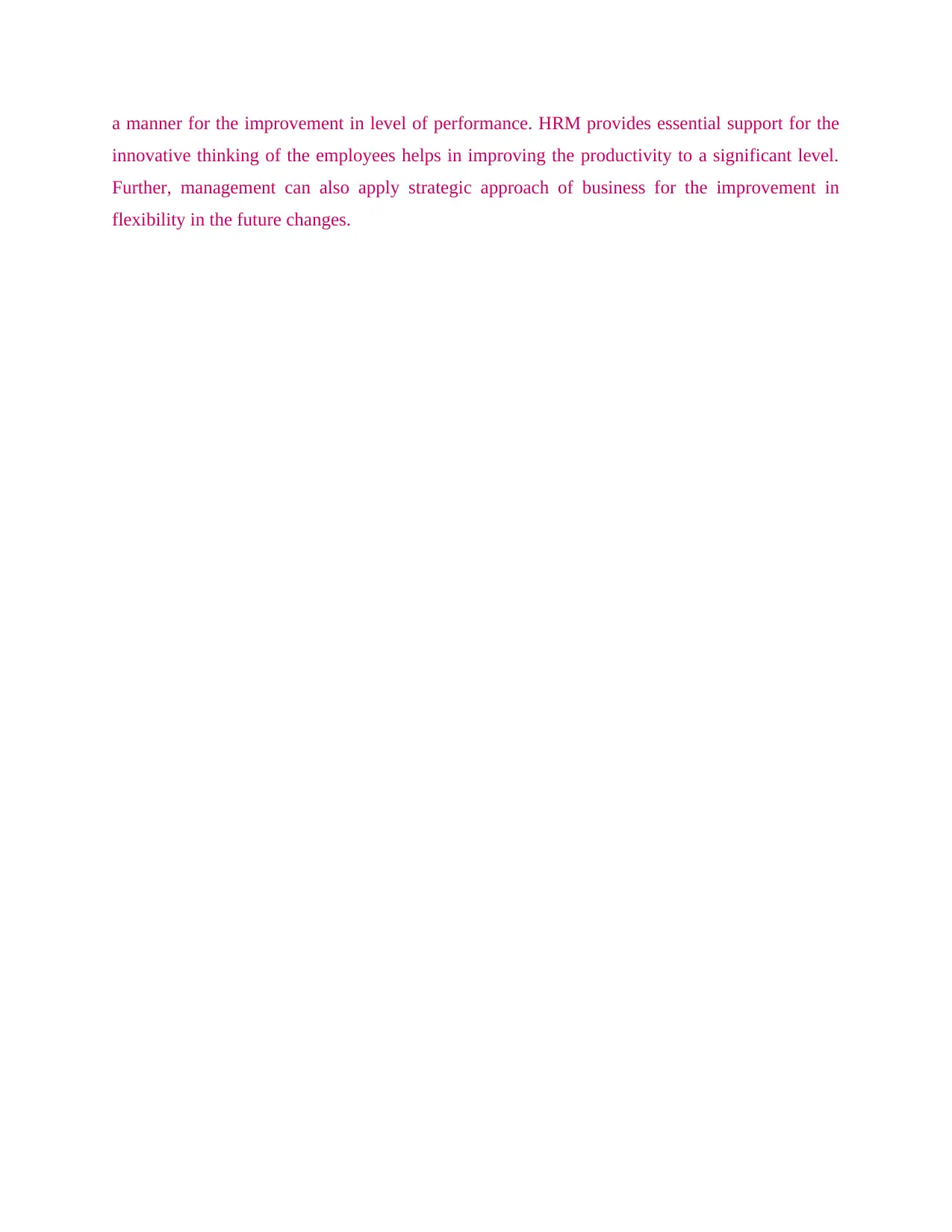
a manner for the improvement in level of performance. HRM provides essential support for the
innovative thinking of the employees helps in improving the productivity to a significant level.
Further, management can also apply strategic approach of business for the improvement in
flexibility in the future changes.
innovative thinking of the employees helps in improving the productivity to a significant level.
Further, management can also apply strategic approach of business for the improvement in
flexibility in the future changes.
Paraphrase This Document
Need a fresh take? Get an instant paraphrase of this document with our AI Paraphraser
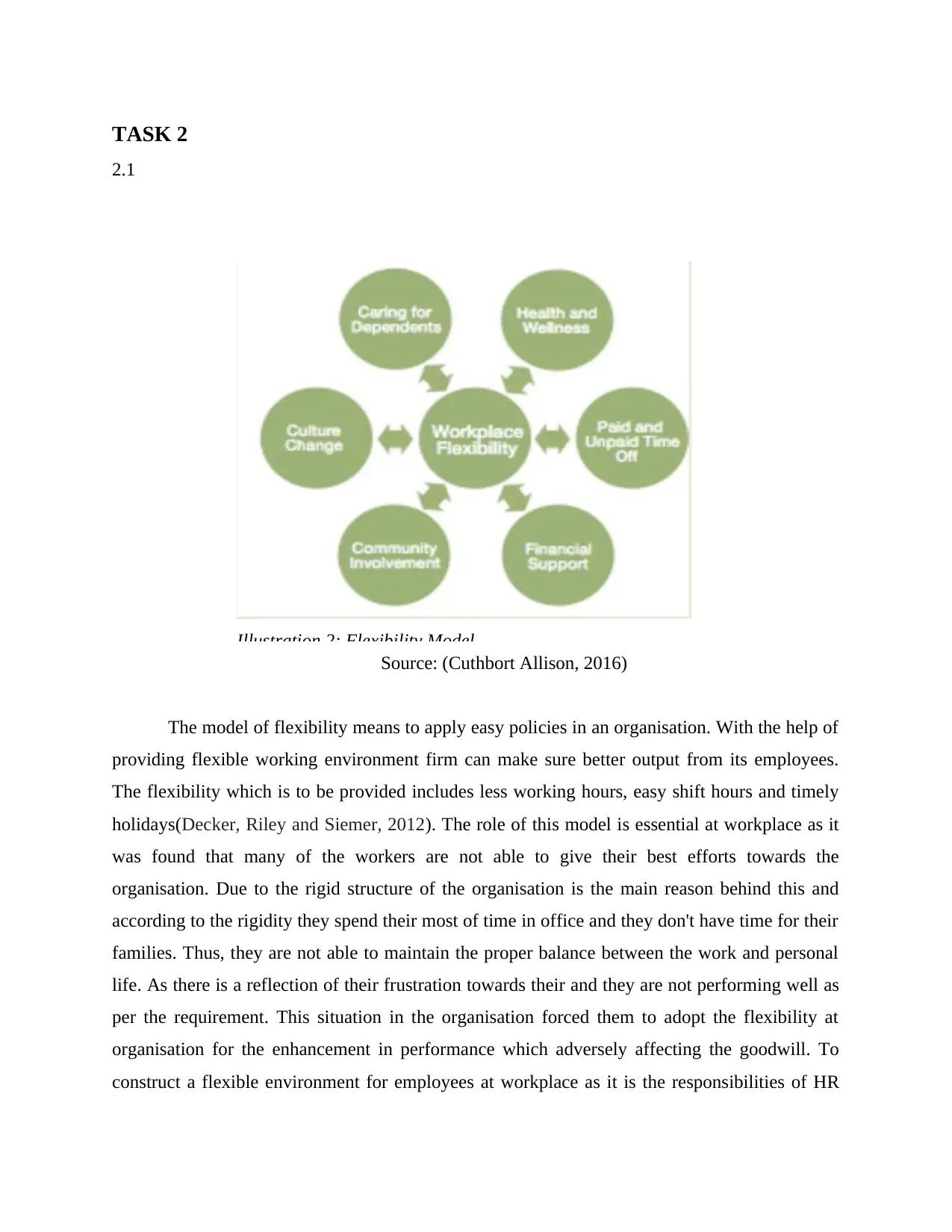
TASK 2
2.1
Source: (Cuthbort Allison, 2016)
The model of flexibility means to apply easy policies in an organisation. With the help of
providing flexible working environment firm can make sure better output from its employees.
The flexibility which is to be provided includes less working hours, easy shift hours and timely
holidays(Decker, Riley and Siemer, 2012). The role of this model is essential at workplace as it
was found that many of the workers are not able to give their best efforts towards the
organisation. Due to the rigid structure of the organisation is the main reason behind this and
according to the rigidity they spend their most of time in office and they don't have time for their
families. Thus, they are not able to maintain the proper balance between the work and personal
life. As there is a reflection of their frustration towards their and they are not performing well as
per the requirement. This situation in the organisation forced them to adopt the flexibility at
organisation for the enhancement in performance which adversely affecting the goodwill. To
construct a flexible environment for employees at workplace as it is the responsibilities of HR
Illustration 2: Flexibility Model
2.1
Source: (Cuthbort Allison, 2016)
The model of flexibility means to apply easy policies in an organisation. With the help of
providing flexible working environment firm can make sure better output from its employees.
The flexibility which is to be provided includes less working hours, easy shift hours and timely
holidays(Decker, Riley and Siemer, 2012). The role of this model is essential at workplace as it
was found that many of the workers are not able to give their best efforts towards the
organisation. Due to the rigid structure of the organisation is the main reason behind this and
according to the rigidity they spend their most of time in office and they don't have time for their
families. Thus, they are not able to maintain the proper balance between the work and personal
life. As there is a reflection of their frustration towards their and they are not performing well as
per the requirement. This situation in the organisation forced them to adopt the flexibility at
organisation for the enhancement in performance which adversely affecting the goodwill. To
construct a flexible environment for employees at workplace as it is the responsibilities of HR
Illustration 2: Flexibility Model
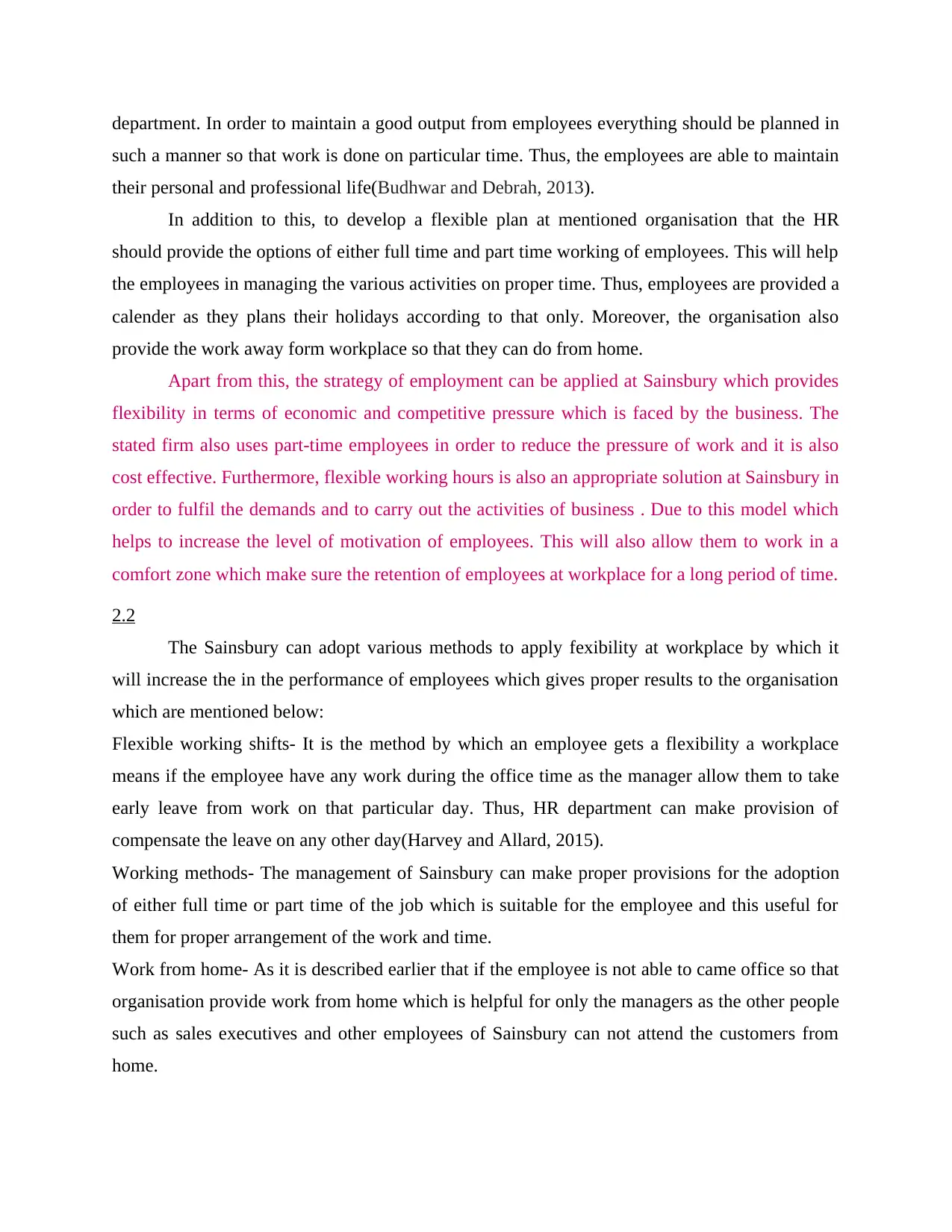
department. In order to maintain a good output from employees everything should be planned in
such a manner so that work is done on particular time. Thus, the employees are able to maintain
their personal and professional life(Budhwar and Debrah, 2013).
In addition to this, to develop a flexible plan at mentioned organisation that the HR
should provide the options of either full time and part time working of employees. This will help
the employees in managing the various activities on proper time. Thus, employees are provided a
calender as they plans their holidays according to that only. Moreover, the organisation also
provide the work away form workplace so that they can do from home.
Apart from this, the strategy of employment can be applied at Sainsbury which provides
flexibility in terms of economic and competitive pressure which is faced by the business. The
stated firm also uses part-time employees in order to reduce the pressure of work and it is also
cost effective. Furthermore, flexible working hours is also an appropriate solution at Sainsbury in
order to fulfil the demands and to carry out the activities of business . Due to this model which
helps to increase the level of motivation of employees. This will also allow them to work in a
comfort zone which make sure the retention of employees at workplace for a long period of time.
2.2
The Sainsbury can adopt various methods to apply fexibility at workplace by which it
will increase the in the performance of employees which gives proper results to the organisation
which are mentioned below:
Flexible working shifts- It is the method by which an employee gets a flexibility a workplace
means if the employee have any work during the office time as the manager allow them to take
early leave from work on that particular day. Thus, HR department can make provision of
compensate the leave on any other day(Harvey and Allard, 2015).
Working methods- The management of Sainsbury can make proper provisions for the adoption
of either full time or part time of the job which is suitable for the employee and this useful for
them for proper arrangement of the work and time.
Work from home- As it is described earlier that if the employee is not able to came office so that
organisation provide work from home which is helpful for only the managers as the other people
such as sales executives and other employees of Sainsbury can not attend the customers from
home.
such a manner so that work is done on particular time. Thus, the employees are able to maintain
their personal and professional life(Budhwar and Debrah, 2013).
In addition to this, to develop a flexible plan at mentioned organisation that the HR
should provide the options of either full time and part time working of employees. This will help
the employees in managing the various activities on proper time. Thus, employees are provided a
calender as they plans their holidays according to that only. Moreover, the organisation also
provide the work away form workplace so that they can do from home.
Apart from this, the strategy of employment can be applied at Sainsbury which provides
flexibility in terms of economic and competitive pressure which is faced by the business. The
stated firm also uses part-time employees in order to reduce the pressure of work and it is also
cost effective. Furthermore, flexible working hours is also an appropriate solution at Sainsbury in
order to fulfil the demands and to carry out the activities of business . Due to this model which
helps to increase the level of motivation of employees. This will also allow them to work in a
comfort zone which make sure the retention of employees at workplace for a long period of time.
2.2
The Sainsbury can adopt various methods to apply fexibility at workplace by which it
will increase the in the performance of employees which gives proper results to the organisation
which are mentioned below:
Flexible working shifts- It is the method by which an employee gets a flexibility a workplace
means if the employee have any work during the office time as the manager allow them to take
early leave from work on that particular day. Thus, HR department can make provision of
compensate the leave on any other day(Harvey and Allard, 2015).
Working methods- The management of Sainsbury can make proper provisions for the adoption
of either full time or part time of the job which is suitable for the employee and this useful for
them for proper arrangement of the work and time.
Work from home- As it is described earlier that if the employee is not able to came office so that
organisation provide work from home which is helpful for only the managers as the other people
such as sales executives and other employees of Sainsbury can not attend the customers from
home.
⊘ This is a preview!⊘
Do you want full access?
Subscribe today to unlock all pages.

Trusted by 1+ million students worldwide
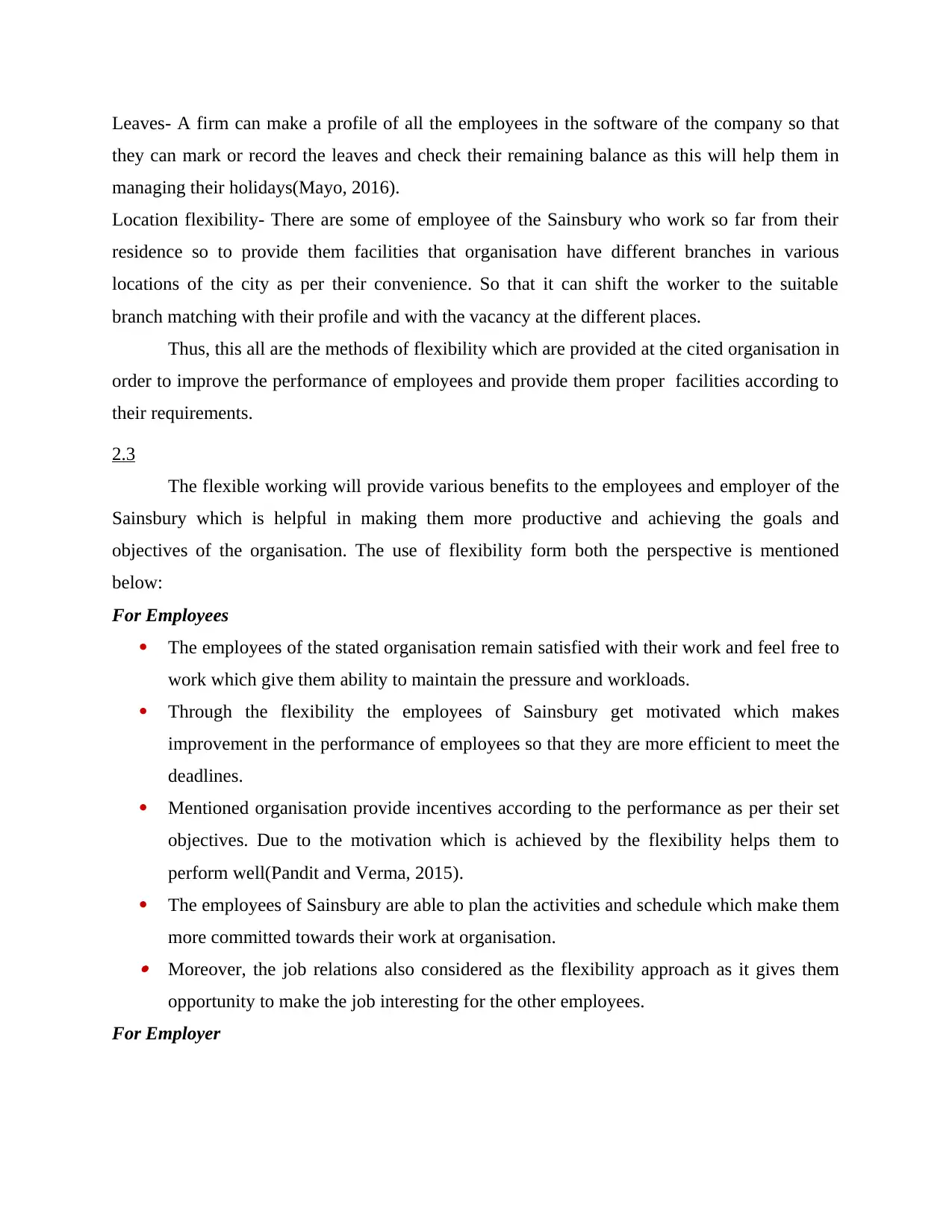
Leaves- A firm can make a profile of all the employees in the software of the company so that
they can mark or record the leaves and check their remaining balance as this will help them in
managing their holidays(Mayo, 2016).
Location flexibility- There are some of employee of the Sainsbury who work so far from their
residence so to provide them facilities that organisation have different branches in various
locations of the city as per their convenience. So that it can shift the worker to the suitable
branch matching with their profile and with the vacancy at the different places.
Thus, this all are the methods of flexibility which are provided at the cited organisation in
order to improve the performance of employees and provide them proper facilities according to
their requirements.
2.3
The flexible working will provide various benefits to the employees and employer of the
Sainsbury which is helpful in making them more productive and achieving the goals and
objectives of the organisation. The use of flexibility form both the perspective is mentioned
below:
For Employees
The employees of the stated organisation remain satisfied with their work and feel free to
work which give them ability to maintain the pressure and workloads.
Through the flexibility the employees of Sainsbury get motivated which makes
improvement in the performance of employees so that they are more efficient to meet the
deadlines.
Mentioned organisation provide incentives according to the performance as per their set
objectives. Due to the motivation which is achieved by the flexibility helps them to
perform well(Pandit and Verma, 2015).
The employees of Sainsbury are able to plan the activities and schedule which make them
more committed towards their work at organisation. Moreover, the job relations also considered as the flexibility approach as it gives them
opportunity to make the job interesting for the other employees.
For Employer
they can mark or record the leaves and check their remaining balance as this will help them in
managing their holidays(Mayo, 2016).
Location flexibility- There are some of employee of the Sainsbury who work so far from their
residence so to provide them facilities that organisation have different branches in various
locations of the city as per their convenience. So that it can shift the worker to the suitable
branch matching with their profile and with the vacancy at the different places.
Thus, this all are the methods of flexibility which are provided at the cited organisation in
order to improve the performance of employees and provide them proper facilities according to
their requirements.
2.3
The flexible working will provide various benefits to the employees and employer of the
Sainsbury which is helpful in making them more productive and achieving the goals and
objectives of the organisation. The use of flexibility form both the perspective is mentioned
below:
For Employees
The employees of the stated organisation remain satisfied with their work and feel free to
work which give them ability to maintain the pressure and workloads.
Through the flexibility the employees of Sainsbury get motivated which makes
improvement in the performance of employees so that they are more efficient to meet the
deadlines.
Mentioned organisation provide incentives according to the performance as per their set
objectives. Due to the motivation which is achieved by the flexibility helps them to
perform well(Pandit and Verma, 2015).
The employees of Sainsbury are able to plan the activities and schedule which make them
more committed towards their work at organisation. Moreover, the job relations also considered as the flexibility approach as it gives them
opportunity to make the job interesting for the other employees.
For Employer
Paraphrase This Document
Need a fresh take? Get an instant paraphrase of this document with our AI Paraphraser
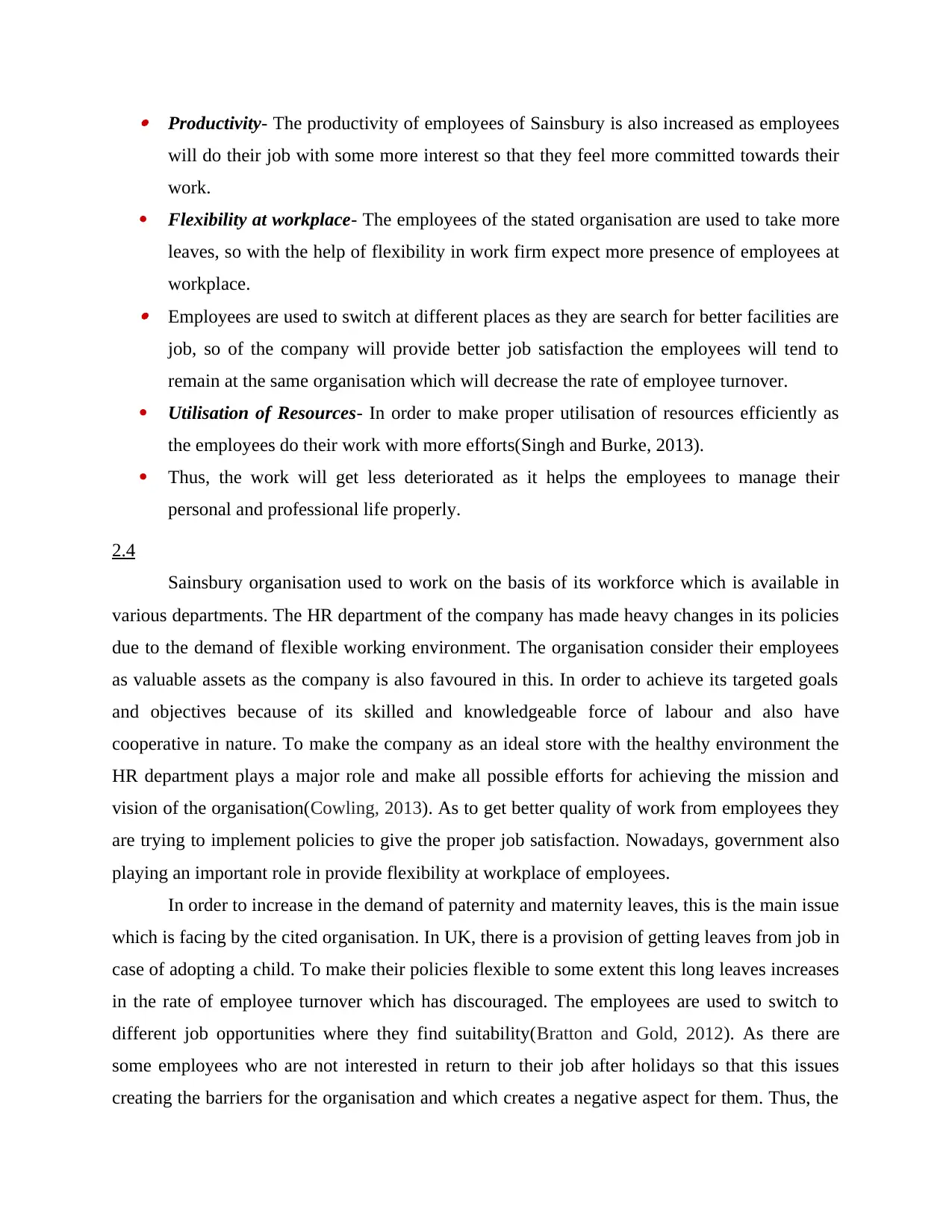
Productivity- The productivity of employees of Sainsbury is also increased as employees
will do their job with some more interest so that they feel more committed towards their
work.
Flexibility at workplace- The employees of the stated organisation are used to take more
leaves, so with the help of flexibility in work firm expect more presence of employees at
workplace. Employees are used to switch at different places as they are search for better facilities are
job, so of the company will provide better job satisfaction the employees will tend to
remain at the same organisation which will decrease the rate of employee turnover.
Utilisation of Resources- In order to make proper utilisation of resources efficiently as
the employees do their work with more efforts(Singh and Burke, 2013).
Thus, the work will get less deteriorated as it helps the employees to manage their
personal and professional life properly.
2.4
Sainsbury organisation used to work on the basis of its workforce which is available in
various departments. The HR department of the company has made heavy changes in its policies
due to the demand of flexible working environment. The organisation consider their employees
as valuable assets as the company is also favoured in this. In order to achieve its targeted goals
and objectives because of its skilled and knowledgeable force of labour and also have
cooperative in nature. To make the company as an ideal store with the healthy environment the
HR department plays a major role and make all possible efforts for achieving the mission and
vision of the organisation(Cowling, 2013). As to get better quality of work from employees they
are trying to implement policies to give the proper job satisfaction. Nowadays, government also
playing an important role in provide flexibility at workplace of employees.
In order to increase in the demand of paternity and maternity leaves, this is the main issue
which is facing by the cited organisation. In UK, there is a provision of getting leaves from job in
case of adopting a child. To make their policies flexible to some extent this long leaves increases
in the rate of employee turnover which has discouraged. The employees are used to switch to
different job opportunities where they find suitability(Bratton and Gold, 2012). As there are
some employees who are not interested in return to their job after holidays so that this issues
creating the barriers for the organisation and which creates a negative aspect for them. Thus, the
will do their job with some more interest so that they feel more committed towards their
work.
Flexibility at workplace- The employees of the stated organisation are used to take more
leaves, so with the help of flexibility in work firm expect more presence of employees at
workplace. Employees are used to switch at different places as they are search for better facilities are
job, so of the company will provide better job satisfaction the employees will tend to
remain at the same organisation which will decrease the rate of employee turnover.
Utilisation of Resources- In order to make proper utilisation of resources efficiently as
the employees do their work with more efforts(Singh and Burke, 2013).
Thus, the work will get less deteriorated as it helps the employees to manage their
personal and professional life properly.
2.4
Sainsbury organisation used to work on the basis of its workforce which is available in
various departments. The HR department of the company has made heavy changes in its policies
due to the demand of flexible working environment. The organisation consider their employees
as valuable assets as the company is also favoured in this. In order to achieve its targeted goals
and objectives because of its skilled and knowledgeable force of labour and also have
cooperative in nature. To make the company as an ideal store with the healthy environment the
HR department plays a major role and make all possible efforts for achieving the mission and
vision of the organisation(Cowling, 2013). As to get better quality of work from employees they
are trying to implement policies to give the proper job satisfaction. Nowadays, government also
playing an important role in provide flexibility at workplace of employees.
In order to increase in the demand of paternity and maternity leaves, this is the main issue
which is facing by the cited organisation. In UK, there is a provision of getting leaves from job in
case of adopting a child. To make their policies flexible to some extent this long leaves increases
in the rate of employee turnover which has discouraged. The employees are used to switch to
different job opportunities where they find suitability(Bratton and Gold, 2012). As there are
some employees who are not interested in return to their job after holidays so that this issues
creating the barriers for the organisation and which creates a negative aspect for them. Thus, the
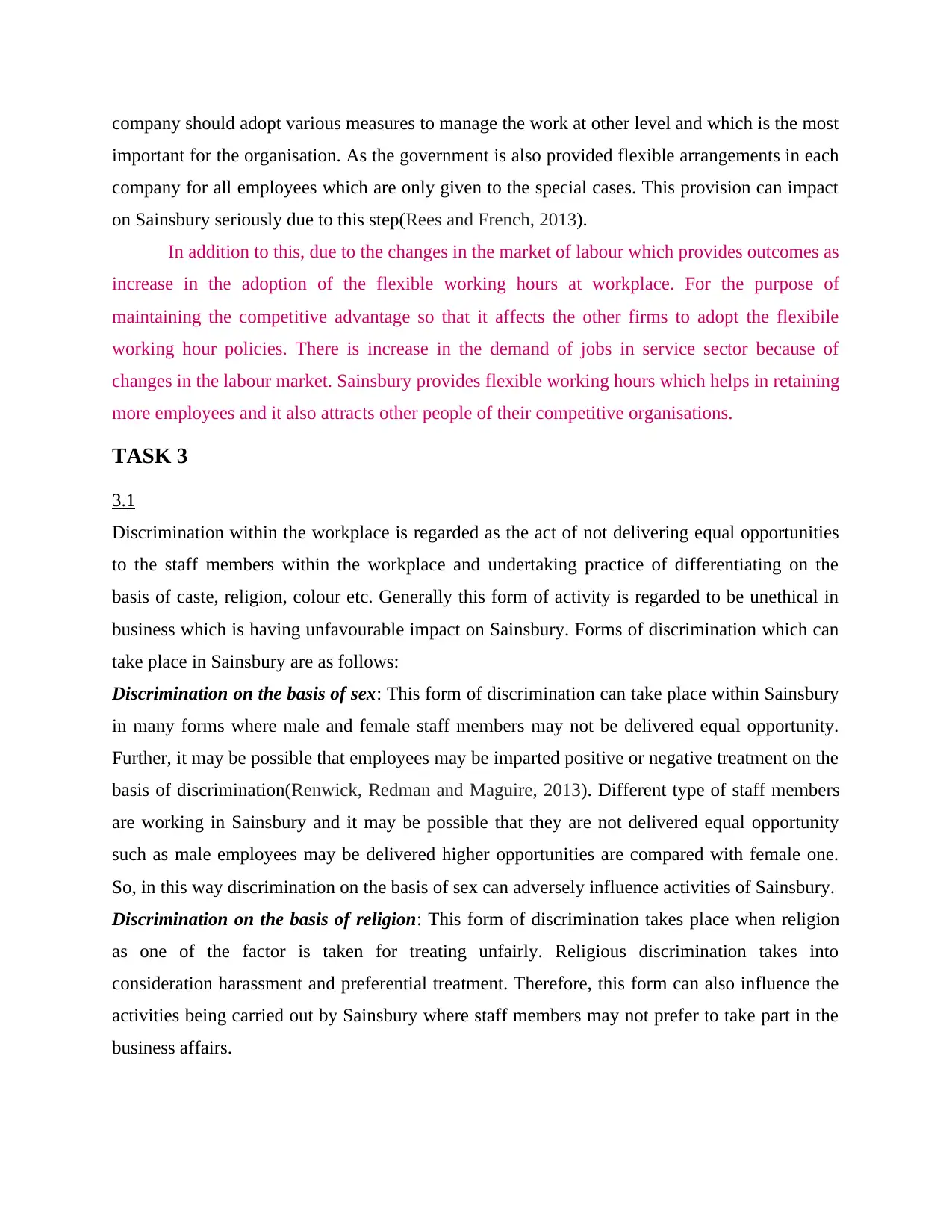
company should adopt various measures to manage the work at other level and which is the most
important for the organisation. As the government is also provided flexible arrangements in each
company for all employees which are only given to the special cases. This provision can impact
on Sainsbury seriously due to this step(Rees and French, 2013).
In addition to this, due to the changes in the market of labour which provides outcomes as
increase in the adoption of the flexible working hours at workplace. For the purpose of
maintaining the competitive advantage so that it affects the other firms to adopt the flexibile
working hour policies. There is increase in the demand of jobs in service sector because of
changes in the labour market. Sainsbury provides flexible working hours which helps in retaining
more employees and it also attracts other people of their competitive organisations.
TASK 3
3.1
Discrimination within the workplace is regarded as the act of not delivering equal opportunities
to the staff members within the workplace and undertaking practice of differentiating on the
basis of caste, religion, colour etc. Generally this form of activity is regarded to be unethical in
business which is having unfavourable impact on Sainsbury. Forms of discrimination which can
take place in Sainsbury are as follows:
Discrimination on the basis of sex: This form of discrimination can take place within Sainsbury
in many forms where male and female staff members may not be delivered equal opportunity.
Further, it may be possible that employees may be imparted positive or negative treatment on the
basis of discrimination(Renwick, Redman and Maguire, 2013). Different type of staff members
are working in Sainsbury and it may be possible that they are not delivered equal opportunity
such as male employees may be delivered higher opportunities are compared with female one.
So, in this way discrimination on the basis of sex can adversely influence activities of Sainsbury.
Discrimination on the basis of religion: This form of discrimination takes place when religion
as one of the factor is taken for treating unfairly. Religious discrimination takes into
consideration harassment and preferential treatment. Therefore, this form can also influence the
activities being carried out by Sainsbury where staff members may not prefer to take part in the
business affairs.
important for the organisation. As the government is also provided flexible arrangements in each
company for all employees which are only given to the special cases. This provision can impact
on Sainsbury seriously due to this step(Rees and French, 2013).
In addition to this, due to the changes in the market of labour which provides outcomes as
increase in the adoption of the flexible working hours at workplace. For the purpose of
maintaining the competitive advantage so that it affects the other firms to adopt the flexibile
working hour policies. There is increase in the demand of jobs in service sector because of
changes in the labour market. Sainsbury provides flexible working hours which helps in retaining
more employees and it also attracts other people of their competitive organisations.
TASK 3
3.1
Discrimination within the workplace is regarded as the act of not delivering equal opportunities
to the staff members within the workplace and undertaking practice of differentiating on the
basis of caste, religion, colour etc. Generally this form of activity is regarded to be unethical in
business which is having unfavourable impact on Sainsbury. Forms of discrimination which can
take place in Sainsbury are as follows:
Discrimination on the basis of sex: This form of discrimination can take place within Sainsbury
in many forms where male and female staff members may not be delivered equal opportunity.
Further, it may be possible that employees may be imparted positive or negative treatment on the
basis of discrimination(Renwick, Redman and Maguire, 2013). Different type of staff members
are working in Sainsbury and it may be possible that they are not delivered equal opportunity
such as male employees may be delivered higher opportunities are compared with female one.
So, in this way discrimination on the basis of sex can adversely influence activities of Sainsbury.
Discrimination on the basis of religion: This form of discrimination takes place when religion
as one of the factor is taken for treating unfairly. Religious discrimination takes into
consideration harassment and preferential treatment. Therefore, this form can also influence the
activities being carried out by Sainsbury where staff members may not prefer to take part in the
business affairs.
⊘ This is a preview!⊘
Do you want full access?
Subscribe today to unlock all pages.

Trusted by 1+ million students worldwide
1 out of 20
Related Documents
Your All-in-One AI-Powered Toolkit for Academic Success.
+13062052269
info@desklib.com
Available 24*7 on WhatsApp / Email
![[object Object]](/_next/static/media/star-bottom.7253800d.svg)
Unlock your academic potential
Copyright © 2020–2025 A2Z Services. All Rights Reserved. Developed and managed by ZUCOL.





